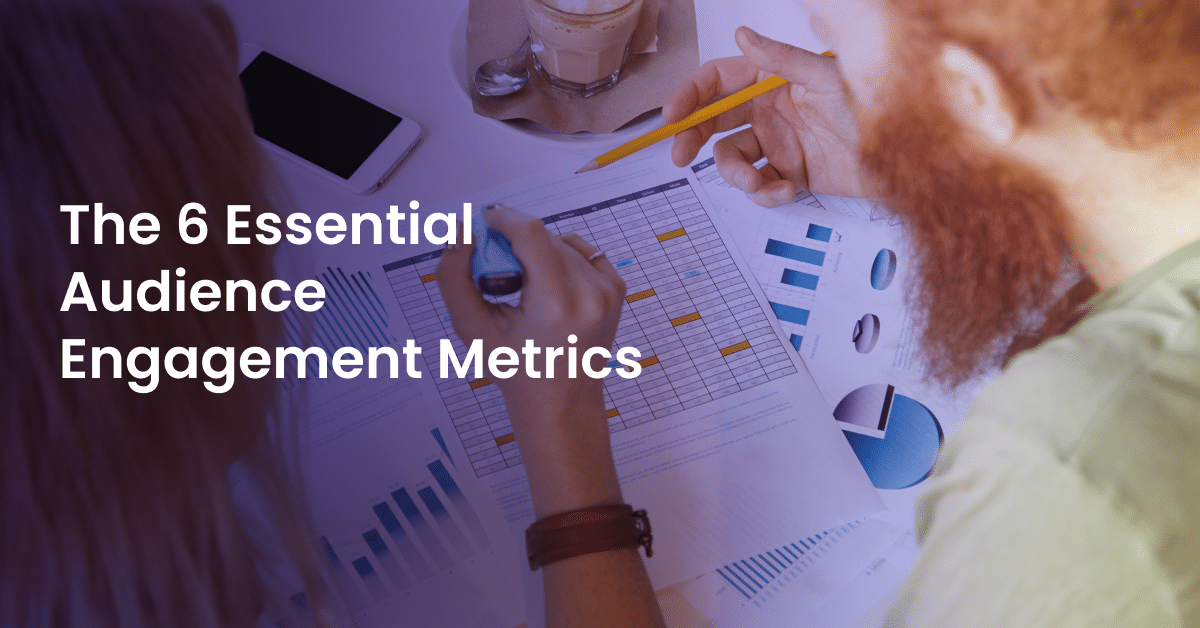Attracting an audience to your website is just the beginning. Knowing if people are interacting effectively with your website is vital. When it comes to tracking, we’ll list the most common metrics below, but before we get into that, it’s also useful to have a concept of how a basic marketing funnel works. Generally speaking, there are three stages to the funnel
Top of Funnel (“ToFu”): behaviors and metrics that happen before, or just at the point of, your first engagement with your audience. Examples include: initial website visits, a request for more information, or signs up for a newsletter
Middle of Funnel (“MoFu”): behavior and metrics that happen after an audience member first engages with your brand, but before they purchase or sign up. Examples include: repeat visits, researching product reviews or case studies.
Bottom of Funnel (“BoFu”): behavior and metrics that track the final actions leading up to, and including, final purchase or signup. Examples include: signing up for a free trial, going through a personalized product demo, or applying for a discount or coupon.
Why Audience Engagement Metrics Add Value
How do you tell if your marketing efforts attract the right audience for your goals? Audience engagement metrics are a powerful way to see if you are progressing effectively. Find out how to use these metrics to assess your website’s performance.
Types of Audience Engagement Metrics
Knowing the types of engagement metrics is like having a map to your audience’s heart. It’s not just about counting likes; it’s about understanding the story behind those numbers.
Qualitative Metrics
- User Feedback: Analyzing comments and reviews gives insight into what your audience values or dislikes.
- Social Shares: The number of times your content is shared can indicate its impact and relevance.
- Mentions and Tags: Track when your brand is mentioned or tagged on social media to gauge its presence and influence.
Quantitative Metrics
- Page Views: Count how many times a page on your site is viewed to measure interest.
- Bounce Rate: Evaluate the percentage of visitors who leave after viewing only one page to identify potential issues.
- Conversion Rates: Measure how many users complete a desired action, like signing up for a newsletter, to assess the effectiveness of your content.
Behavioral Metrics
- Purchase Frequency: Track how often users make purchases to understand buying behavior.
- Sign-Up Rates: Measure how many users register for an account or service.
- Content Interactions: Monitor clicks on videos, downloads, or other interactive elements.
The Six Essential Audience Engagement Metrics
1) Average Session Duration
Average session duration means how much time users spend on your website and is usually the first metric you start with at the top of the funnel.
Generally speaking, a longer session time is better because it means your message and content is resonating with your audience. This metric has limitations, however. If a user leaves a website or switches to another tab in their browser, session duration may continue to increase even though the user is doing something else. As a general rule of thumb, session durations under 30-60 seconds are a warning signal because you are likely to see fewer conversions with so little time.
Balancing this metric with other measures like webpages per session and first-party data generated.
2) Bounce Rate
Bounce rate is the percentage of users who leave your website after viewing a single page on a website. A high bounce rate suggests that users aren’t satisfied with what they find on your website. It’s a useful metric at all stages of the funnel – especially as you’re working to optimize specific landing pages – but it’s especially useful at the top of the funnel and should be one of the first things you optimize for along with session time.
It’s also one of the oldest metrics tracked by website analytics tools. According to Semrush, the average bounce rate for websites varies from 20-25% at the low end for ecommerce and B2B and up to 90% for landing pages, blogs and portals.
It’s also helpful to measure bounce rates by page. For example, a blog post targeting a high-value search keyword should aspire to a lower bounce rate if it is well-optimized. However, other pages on your website might have a relatively higher bounce rate if they are less optimized.
3) Returning Visitors vs New Visitors
This metric gives you a broader view of your audience and is one of the first middle of funnel metrics to optimize. If a website has few returning visitors, that is a warning signal. Few returning visitors may imply that users see no value in returning to your website.
One way to improve the number of returning visitors to your website is to provide new engaging content and experiences live a Live Blog that provides continuous updates for breaking news or continued coverage of an ongoing trend. Other successful tactics include hosting a regular event (weekly, monthly, etc) so that your audience becomes accustomed to returning to your site at a regular cadence.
To help your audience remember, you can help direct them back to your website through email & social campaigns or mobile push notifications.
4) Social Media Shares

Social shares are an interesting engagement metric because it requires user action. However, a social share doesn’t entail the same level of commitment as a conversion or purchase so it may feel more accessible.
Interestingly, social shares can happen at any point in the funnel as current customers, or audience members in the middle of your funnel, may wind up sharing content to their own audience who’ve never encountered your brand before, which then becomes a top of funnel experience for them.
Tracking social shares over time can tell you which content, themes and pages resonate with your audience. For example, you may find that an online event with Arena live chat prompts increased social shares and traffic. Or you might find that video content prompts the most social share activity.
While social sharing is helpful, keep the drawbacks in mind. It can be challenging to achieve your growth goals when people engage with your brand on social media rather than on your website. The trick is to encourage social shares that contain teasers or calls to action that invite people back to your domain.
For instance, create a quote image to share a comment from a keynote and include a CTA to experience the full keynote speech on your website, or use social media to promote a coupon or discount that is only redeemable on your website, or ecommerce storefront.
5) Average Web Pages Per Session

Holding everything else equal, a person who visits multiple web pages is more valuable than someone who only visits a single page. That said, not all pages are created equal. Compare two visitors who visit different pages for a B2B company.
- Visitor A: visits a blog post and then visits the contact page to request product information.
- Visitor B: visits multiple blog posts and then leaves without opting in to receive more information.
In the short term, visitor A is more valuable than visitor B. To encourage more contact page conversions, look for ways to weave in more links to your contact page.
6) First-party Data Generated
Your audience is busy, so it is vital to have a way to get in touch with them after they leave your website. That’s the first reason why you want to have a “first party” connection with your audience, such as having them join your email list. The second reason is that a person who provides information about their interests and preferences through clicks and participation in online events is easier to engage.
The amount of first-party data you can gather from your audience is limited only by your technology and creativity! Here are two specific first-party data metrics you can use to get started.
Email List Signup
Email marketing remains one of the most reliable and effective ways to engage audiences. Therefore, encouraging website visitors to sign up for your list should be a goal. After a person joins your email list, you will have the chance to gather additional first-party insights by observing their email engagement (e.g. link clicks, opens, replies).
Online Event Participation
Track the quantity and quality of engagement with your online events. For instance, a brand that hosts a monthly event with live chat might consider anybody who participates in more than one event in three months highly engaged.
How To Use Audience Engagement Metrics For Growth
Gathering and reviewing all of these engagement metrics is a good starting point. Yet, your audience will not grow simply through data gathering (wouldn’t that make life easy!). Instead, it’s essential to leverage engagement metrics in your workflow.
Use these tactics to make sure you get full value from all of the engagement metrics you’re gathering.
Identify Red Flags
If multiple metrics (e.g., bounce rate increases and social shares fall) trend in the wrong direction for a prolonged period of time, that may be a red flag. Left unchecked, your audience engagement and growth goals may suffer if such red flags are ignored.
Clarify The Audience/Customer Journey
We all make assumptions about how our audience members and customers engage with us. You might assume that a person needs to visit your website daily for five days to become a regular visitor and then a customer in the next 90 days. The audience engagement metrics above – especially first-party data – can clarify if your assumptions are valid so that you can plan future growth effectively.
Develop And Test New Content and Campaigns
Developing growth ideas and tactics from a blank page is tough! Fortunately, audience engagement metrics save you time and money here. When a given piece of content resonates across multiple engagement metrics, that is a solid signal to create more content on a similar theme to keep your audience coming back for more.
Benefits of Measuring Audience Engagement
Measuring audience engagement transforms data into decisions that drive growth. Understanding user preferences allows you to tailor content to their tastes. Engagement metrics help boost conversions by identifying which content leads to conversions. Engaged audiences are loyal audiences, and measuring engagement helps foster those connections.
How Does Arena’s Platform Work?
Arena’s platform collects real-time data, giving instant insights into user behavior. With AI-driven analytics, Arena segments your audience with precision, allowing tailored strategies. Arena doesn’t just stop at metrics; it actively improves engagement with features like live chat and dynamic live blogs.
How to Measure Audience Engagement Effectively
Set clear goals to give your engagement metrics context. Use comprehensive tools like Arena for deeper insights. Regularly review metrics to identify trends and adjust strategies to focus on what works.
Strategies to Improve Audience Engagement
Interactive Content Creation
Combat boredom with interactive content like polls and quizzes. Use Arena’s interactive features to integrate these into your content strategy.
Personalized User Experiences
Tailor content to individual user preferences using data-driven insights. Delivering personalized experiences makes your audience feel seen and valued.
Community Building
Foster a sense of community through active forums and discussions. Arena’s community tools enable vibrant spaces for user interacti
Lifting Audience Engagement Is Easier With These Tools
The art of growing your audience loyalty over time takes significant effort, some risk and creativity. There are ways to make it easier! Install Arena Live Chat and Arena Live Blog on your website. These tools make it simple and easy to create engaging experiences that will draw in your audience. Discover how to build a thriving community right on your website.



